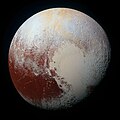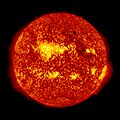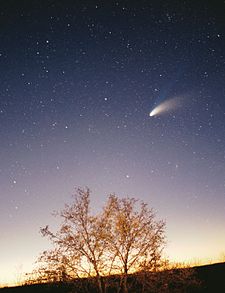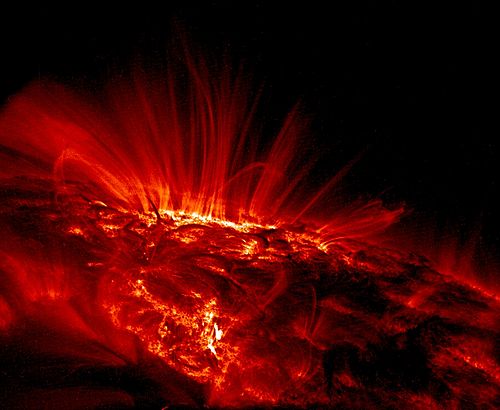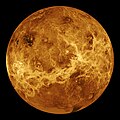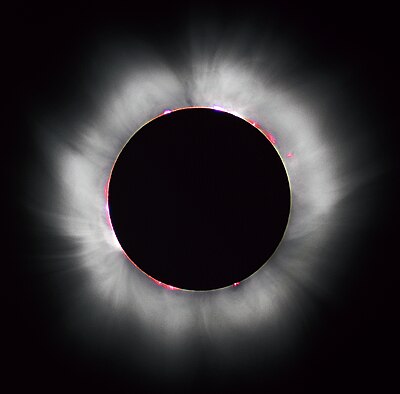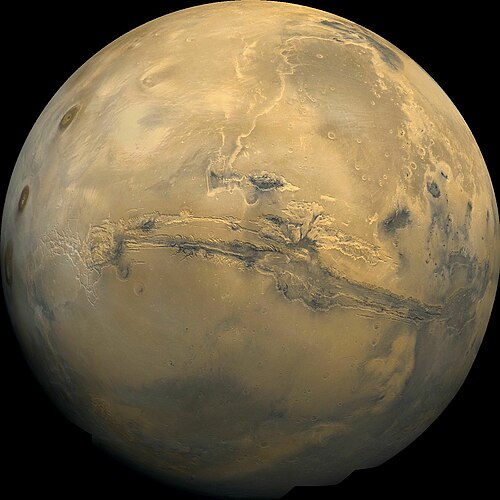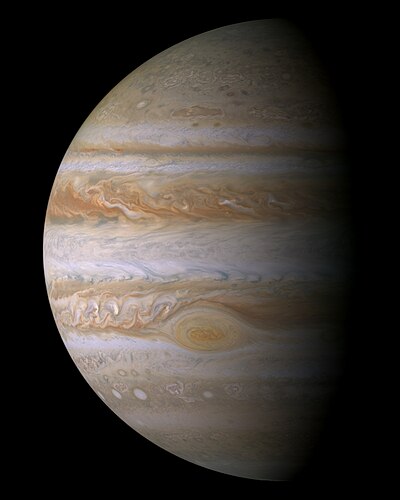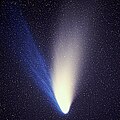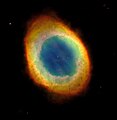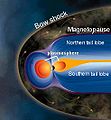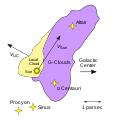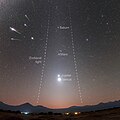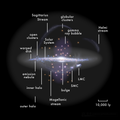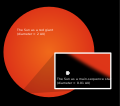
Back Portal:Sistem mata uroe ACE بوابة:المجموعة الشمسية Arabic بوابة:المجموعة الشمسية ARZ Portal:Günəş sistemi AZ Portal:Sistema solar Catalan دەروازە:کۆمەڵەی خۆر CKB Portál:Sluneční soustava Czech Πύλη:Ηλιακό Σύστημα Greek Portal:Sistema solar Spanish Atari:Eguzki-sistema EU
The Solar System Portal

The Solar System is the gravitationally bound system of the Sun and the objects that orbit it. It formed about 4.6 billion years ago when a dense region of a molecular cloud collapsed, forming the Sun and a protoplanetary disc. The Sun is a typical star that maintains a balanced equilibrium by the fusion of hydrogen into helium at its core, releasing this energy from its outer photosphere. Astronomers classify it as a G-type main-sequence star.
The largest objects that orbit the Sun are the eight planets. In order from the Sun, they are four terrestrial planets (Mercury, Venus, Earth and Mars); two gas giants (Jupiter and Saturn); and two ice giants (Uranus and Neptune). All terrestrial planets have solid surfaces. Inversely, all giant planets do not have a definite surface, as they are mainly composed of gases and liquids. Over 99.86% of the Solar System's mass is in the Sun and nearly 90% of the remaining mass is in Jupiter and Saturn.
There is a strong consensus among astronomers that the Solar System has at least nine dwarf planets: Ceres, Orcus, Pluto, Haumea, Quaoar, Makemake, Gonggong, Eris, and Sedna. There are a vast number of small Solar System bodies, such as asteroids, comets, centaurs, meteoroids, and interplanetary dust clouds. Some of these bodies are in the asteroid belt (between Mars's and Jupiter's orbit) and the Kuiper belt (just outside Neptune's orbit). Six planets, seven dwarf planets, and other bodies have orbiting natural satellites, which are commonly called 'moons'.
The Solar System is constantly flooded by the Sun's charged particles, the solar wind, forming the heliosphere. Around 75–90 astronomical units from the Sun, the solar wind is halted, resulting in the heliopause. This is the boundary of the Solar System to interstellar space. The outermost region of the Solar System is the theorized Oort cloud, the source for long-period comets, extending to a radius of 2,000–200,000 AU. The closest star to the Solar System, Proxima Centauri, is 4.25 light-years (269,000 AU) away. Both stars belong to the Milky Way galaxy. (Full article...)
Selected article –
Selected picture
General images
The following are images from various Solar System-related articles on Wikipedia.
Did you know –
- ...that New York's Panther Mountain (pictured) was the site of a prehistoric meteor crash?
- ...that the Beethoven crater in the Beethoven quadrangle on Mercury is the eleventh largest named impact crater in the Solar System?
- ...that the planet Mars appears red primarily because of a ubiquitous layer of dust containing nanophase ferric oxides?
- ...that the 1997 volcanic eruption of Pillan Patera on Jupiter's moon Io was the largest effusive eruption ever witnessed?
- ...that ridges and escarpments in the Victoria quadrangle of the planet Mercury have been associated with the stresses caused by the Sun slowing Mercury's rotation through tidal forces?
- ...that J002E3 was at first thought to be a new moon of Earth when discovered in 2002 but was later found to be the third stage of the Apollo 12 Saturn V?
- ...that the Tooting impact crater on Mars was named after the London suburb of the same name because the discoverer "thought [his] mum and brother would get a kick out of having their home town paired with a land form on Mars"?
- ...that 99% of the mass of the Carme group, a group of retrograde irregular satellites of Jupiter, is located in Carme?
Categories
| Solar System | ||
|---|---|---|

|
||
| Celestial mechanics | Comets | ...in fiction |

|

| |
| Minor planets | Moons | Planetary missions |

|

|

|
| Planets... | Sun | Surface feature nomenclature... |

In the news
- April 7: NASA's helicopter Ingenuity survives its first night at Mars
- December 25: 'Earth-based life can survive in hydrogen-rich atmospheres': MIT professor Dr Seager tells Wikinews about her research on organisms thriving in oxygen-less environment
- July 7: Astronomer Anthony Boccaletti discusses observation of birth of potential exoplanet with Wikinews
- May 31: SpaceX successfully launches its first crewed spaceflight
- May 22: Astronomer tells Wikinews about discovery of closest black hole known so far
- October 12: Cosmonaut Alexei Leonov dies at age 85
- October 10: Swedish academy announces 2019 Nobel Prize winners in physics
- September 14: Astronomers find water vapour in atmosphere of exoplanet K2-18b
- March 5: SpaceX Crew Dragon capsule docks with International Space Station
- January 9: Simple animals could live in Martian brines: Wikinews interviews planetary scientist Vlada Stamenković
- November 29: NASA's InSight Lander makes it to Mars
- October 12: Manned Soyuz space mission aborts during launch
Major topics

Solar System: Planets (Definition · Planetary habitability · Terrestrial planets · Gas giants · Rings) · Dwarf planets (Plutoid) · Colonization · Discovery timelineˑ Exploration · Moons · Planetariums
- Sun: Sunspot · Solar wind · Solar flare · Solar eclipse
- Mercury: Geology · Exploration (Mariner 10 · MESSENGER · BepiColombo) · Transit
- Venus: Geology · Atmosphere · Exploration (Venera · Mariner program 2/5/10 · Pioneer · Vega 1/2ˑ Magellan · Venus Express) · Transit
- Earth: History · Geology · Geography · Atmosphere · Rotation
- Moon: Geology · Selenography · Atmosphere · Exploration (Luna · Apollo 8/11) · Orbit · Lunar eclipse
- Mars: Moons (Phobos · Deimos) · Geology · Geography · Atmosphere · Exploration (Mariner · Mars · Viking 1/2 · Pathfinder · MER)
- Ceres: Exploration (Dawn)
- Jupiter: Moons (Amalthea, Io · Europa · Ganymede · Callisto) · Rings · Atmosphere · Magnetosphere · Exploration (Pioneer 10/11 · Voyager 1/2 · Ulysses · Cassini · Galileo · New Horizons)
- Saturn: Moons (Mimas · Enceladus · Tethys · Dione · Rhea · Titan · Iapetus) · Rings · Exploration (Pioneer 11 · Voyager 1/2 · Cassini–Huygens)
- Uranus: Moons (Miranda · Ariel · Umbriel · Titania · Oberon) · Rings · Exploration (Voyager 2)
- Neptune: Moons (Triton) · Rings · Exploration (Voyager 2)
- Planets beyond Neptune
- Pluto: Moons (Charon, Nix, Hydra, Kerberos, Styx) · Geology · Atmosphere · Exploration (New Horizons)
- Haumea: Moons (Hi'iaka, Namaka) · Ring
- Quaoar: Weywot · Rings
- Makemake: S/2015 (136472) 1
- Gonggong: Xiangliu
- Eris: Dysnomia
- Sedna
- Small bodies: Meteoroids · Asteroids (Asteroid belt) · Centaurs · TNOs (Kuiper belt · Scattered disc · Oort cloud) · Comets (Hale–Bopp · Halley's · Hyakutake · Shoemaker–Levy 9)
- Formation and evolution of the Solar System: History of Solar System formation and evolution hypotheses · Nebular hypothesis
- See also: Featured content · Featured topic · Good articles · List of objects
Bold articles are featured.
Italicized articles are on dwarf planets or major moons.
Things you can do

 |
Here are some tasks awaiting attention:
|
Related portals
Related WikiProjects
Associated Wikimedia
The following Wikimedia Foundation sister projects provide more on this subject:
-
Commons
Free media repository -
Wikibooks
Free textbooks and manuals -
Wikidata
Free knowledge base -
Wikinews
Free-content news -
Wikiquote
Collection of quotations -
Wikisource
Free-content library -
Wikiversity
Free learning tools -
Wiktionary
Dictionary and thesaurus







